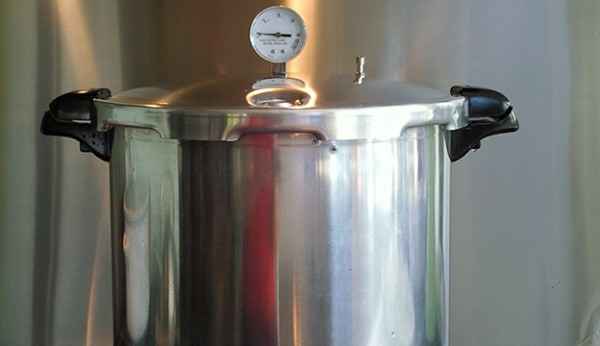
Some things you buy on a whim while strolling through the store: a towel set, plastic glasses for the summer season, a gorgeous candle. But purchasing a pressure canner shouldn’t be a spur-of-the-moment decision because you have several factors to consider besides price.
Buy From a Reputable Source
When I first launched on my own canning journey, the only frame of reference I had was my mother’s pre-1970 model pressure canner: thick-walled with a multi-clamped lid, a dial gauge and a weight on the steam vent. Every canning season she’d hand me another layer of cautionary canner instruction, as if it were only the heavy-duty construction of this canner that stood between us and culinary disaster.
But the pressure canners I found in 1984 were thinner-walled with twist-on lids. I admit that with my upbringing, I was a bit skeptical about whether such a creation could actually be safe. But the USDA and the National Center for Home Food Preservation had no problem with the stream-lined, lighter-weight models, and I had a friend who was on her third year of using one. Because she was still alive and canning, I threw in my vote for the newer design.
Thirty years with that same canner has convinced me that as long as you’re buying from a reputable company in which products have been tested and safety inspected, and you’ll be safe—even if your canner isn’t built like my mother’s.
Lids, Locks and Gauges
Once you determine the pressure canner model you’re eyeing is guaranteed to be safe, take a closer look at the structure to choose the features that are important to you.
Lids
Pressure canner lids come with or without clamps. A clamped-on lid doesn’t need a gasket, which eliminates the need to periodically replace this part, but it takes a bit more time to clamp and unclamp the lid. The beauty of a twist-on lid is speed: Check the gasket, set the lid in position, turn an inch or so to the right, and you’re good to go. The downside? Gaskets can deteriorate over time, necessitating replacement. Ultimately, it seems that most people get comfortable using one or the other, and swear allegiance thereafter. Both types work. Both are time-tested and safe.
Locking Lids
The clamps of a clamp-on lid serve to lock the lid in place. The twist-on varieties have a heat-activated locking mechanism built into the handles, located on either side of the lid. As the temperature climbs, the locking device expands, and until the canner cools, the lid cannot be removed. This prevents accidental opening of the canner while under pressure. Again, either style is safe and functional.
Gauges
The pressure gauge allows you to bring the contents of your jars to the required pressure and maintain that pressure for the duration needed to kill harmful bacteria that would lead to food spoilage. They can be dialed or weighted.
Dial gauges enable you to read the exact pressure within your canner, and this precision can be reassuring. Lids with dial gauges also have a steam vent that the weight sits upon to keep the pressure from building too high. When working with a dial gauge, you’ll need to monitor pressure and adjust heat accordingly. As a safety precaution, take your pressure canner to your local cooperative extension office so they can check the dial gauge for accuracy and recalibrate it as necessary to ensure your food will reach the desired temperature for safe preservation.
A weighted gauge is a simpler design—the gauge, sometimes referred to as a “petcock,” has three different-sized holes equidistant around the edge of the disk labeled 5, 10 and 15. Depending on how much pressure your recipe calls for, that number sits on the steam vent. Steam builds within the canner until it exceeds that selected pressure, at which time, the pressure will slightly unseat the petcock, causing it to jiggle and release a bit of pressure. At this point, you begin timing, reducing/increasing heat to the canner as needed to cause the gauge to jiggle four to six times a minute. Continuous jiggling will cause the water in the canner to evaporate too quickly. Less than four times a minute indicates that your pressure is not high enough. Admittedly, this does sound more labor intensive than glancing at a dial, but the real beauty of a weighted petcock is that it doesn’t need constant monitoring, like the dial gauge—you can hear that your pressure is maintaining.
Again, familiarity seems to be the main factor for choosing a dial gauge over a weighted gauge. Both are safe when used correctly.
Durability And Stability
Durability and heat stability are somewhat linked when it comes to pressure canners. Advocates of heavier-walled canners like the even heat distribution that extra thickness gives and claim they’re easier to hold at a constant temperature while processing foods (your goal in pressure canning). As you’ll find when you start researching, you this extra weight makes the canner more expensive. However, no matter what the thickness of your canner’s walls, it’s likely to withstand the test of time if you buy from a reputable source.
It’s the fittings—the heat-resistant handles, gaskets, valves and gauges—that tend to need replacing periodically, especially if you drop your lid on the floor or your gasket starts losing its sealing ability.
So whether you’re looking into buying your first canner, purchasing one as a gift, or upgrading to a different model or weight, a pressure canner is an investment that, with proper care and maintenance, can fill your pantry with home-canned food for decades to come.




